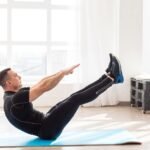Bent-Over Dumbbell Reverse Fly: Exercise Overview
The bent-over dumbbell reverse fly, also known as the rear delt fly, is an effective isolation exercise designed to target the posterior deltoids, a often-underdeveloped shoulder muscle crucial for achieving balanced shoulder aesthetics. This movement also engages the upper back muscles, including the rhomboids and trapezius, to a lesser extent, contributing to improved posture and shoulder stability.
By strengthening the rear deltoids, the reverse fly enhances performance in other lifts, such as bench presses and rows, and supports better shoulder alignment (Schoenfeld, 2010). This exercise is ideal for shoulder-focused workouts, upper-body sessions, or full-body routines, making it a versatile choice for lifters aiming to sculpt well-rounded shoulders and improve functional strength (Wirth et al., 2016).
How to Perform the Bent-Over Dumbbell Reverse Fly
- Select an appropriate pair of dumbbells from the rack and step back into an open area, standing with feet hip-width apart.
- Hinge at your hips, pushing them back until your torso is nearly parallel to the floor (or as far as comfortable), maintaining a slight bend in your knees and a neutral spine.
- Hold the dumbbells with a neutral grip (palms facing inward), letting your arms hang straight down from your shoulders—this is your starting position.
- Engage your core, then raise the dumbbells out to your sides, leading with your rear deltoids, until your arms are roughly parallel to the floor.
- Pause briefly at the top, squeezing your rear delts for maximum contraction.
- Lower the dumbbells back to the starting position with control, keeping tension in the shoulders.
- Repeat for the desired number of repetitions.
Tips for Optimal Performance
- Focus on Rear Delts: Minimize shoulder blade retraction to isolate the posterior deltoids, moving primarily at the shoulder joint rather than the scapula (McGill, 2010).
- Control the Movement: Perform the raise and descent slowly to maximize muscle engagement and avoid momentum, enhancing effectiveness and reducing injury risk (Schoenfeld, 2016).
- Adjust for Comfort: If you experience shoulder discomfort, use a supinated grip (palms facing forward, thumbs outward) to externally rotate the shoulders and reduce strain (Escamilla et al., 2009).
- Maintain a Neutral Spine: Brace your core to prevent arching your back, ensuring proper posture and minimizing lower-back stress.
- Hinge Within Your Range: If a 90-degree hinge isn’t possible, bend as far as comfortable or try a seated variation to maintain form.
- Avoid Locking Elbows: Keep a slight bend in your elbows to protect the joints and maintain focus on the rear delts.
- Breathe Properly: Exhale as you raise the dumbbells and inhale as you lower them to support controlled movement and muscle oxygenation.
Building rear delts with raises? Dive into our Ultimate Guide to Muscle Groups for shoulder development.







